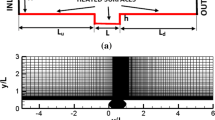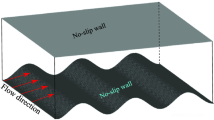Abstract
This study aims to investigate effective slip arising from pressure-driven flow through a slit channel bounded by lubricant-impregnated grooved surfaces. The problem for flow over longitudinal grooves is solved analytically using the methods of domain decomposition and eigenfunction expansion, while that for flow over transverse grooves is solved numerically using the front tracking method. It is found that the effective slip length and the lubricant flow rate can depend strongly on the geometry of the microstructure, the direction of flow, and the lubricant viscosity. In particular, the effective slip can be effectively enhanced by increasing the thickness of a lubricating film atop the ribs. Under the same conditions, a flow that is parallel to the lubricant-impregnated grooves will have a larger effective slip, but also a larger lubricant flow rate, when compared with the case of flow normal to the grooves. It is also shown that, in the case of transverse grooves, because of the downward displacement of the interface between the working/lubricating fluids, the effective slip length and lubricant flow rate may vary non-monotonically with the groove depth.
Similar content being viewed by others
References
Anand, S., Paxson, A.T., Dhiman, R., Smith, J.D., Varanasi, K.K.: Enhanced condensation on lubricant-impregnated nanotextured surfaces. ACS Nano 6(11), 10122–10129 (2012)
Bohn, H.F., Federle, W.: Insect aquaplaning: nepenthes pitcher plants capture prey with the peristome, a fully wettable water-lubricated anisotropic surface. Proc. Natl. Acad. Sci. USA 101(39), 14138–14143 (2004)
Carlson, A., Kim, P., Amberg, G., Stone, H.A.: Short and long time drop dynamics on lubricated substrates. EPL 104(3), 34,008 (2013)
Eifert, A., Paulssen, D., Varanakkottu, S.N., Baier, T., Hardt, S.: Simple fabrication of robust water-repellent surfaces with low contact-angle hysteresis based on impregnation. Adv. Mater. Interfaces 1(3), 1300,138 (2014)
Epstein, A.K., Wong, T.S., Belisle, R.A., Boggs, E.M., Aizenberg, J.: Liquid-infused structured surfaces with exceptional anti-biofouling performance. Proc. Natl. Acad. Sci. 109(33), 13182–13187 (2012)
Huang, X., Chrisman, J.D., Zacharia, N.S.: Omniphobic slippery coatings based on lubricant-infused porous polyelectrolyte multilayers. ACS Macro Lett. 2(9), 826–829 (2013)
Kim, P., Wong, T.S., Alvarenga, J., Kreder, M.J., Adorno-Martinez, W.E., Aizenberg, J.: Liquid-infused nanostructured surfaces with extreme anti-ice and anti-frost performance. ACS Nano 6(8), 6569–6577 (2012)
Lafuma, A., Quéré, D.: Slippery pre-suffused surfaces. EPL 96(5), 56,001 (2011)
Lalia, B.S., Anand, S., Varanasi, K.K., Hashaikeh, R.: Fog-harvesting potential of lubricant-impregnated electrospun nanomats. Langmuir 29(42), 13081–13088 (2013)
Li, J., Kleintschek, T., Rieder, A., Cheng, Y., Baumbach, T., Obst, U., Schwartz, T., Levkin, P.A.: Hydrophobic liquid-infused porous polymer surfaces for antibacterial applications. ACS Appl. Mater. Interfaces 5(14), 6704–6711 (2013)
Liu, H., Zhang, P., Liu, M., Wang, S., Jiang, L.: Organogel-based thin films for self-cleaning on various surfaces. Adv. Mater. 25(32), 4477–4481 (2013)
Ng, C.O., Chen, B.: Microchannel flows with superhydrophobic surfaces: Effects of phase shift of wall patterns. In: Proceedings of the 14th Asian Congress of Fluid Mechanics, pp. 1037–1041 (2013)
Ng, C.O., Chu, H.C.W., Wang, C.Y.: On the effects of liquid–gas interfacial shear on slip flow through a parallel-plate channel with superhydrophobic grooved walls. Phys. Fluids 22(10), 102,002 (2010)
Ng, C.O., Wang, C.Y.: Stokes shear flow over a grating: implications for superhydrophobic slip. Phys. Fluids 21(1), 013,602 (2009)
Ng, C.O., Wang, C.Y.: Stokes flow through a periodically grooved tube. J. Fluids Eng. 132(10), 101,204 (2010)
Ng, C.O., Wang, C.Y.: Effective slip for stokes flow over a surface patterned with two-or three-dimensional protrusions. Fluid Dyn. Res. 43(6), 065,504 (2011)
Ng, C.O., Zhou, Q.: Electro-osmotic flow through a thin channel with gradually varying wall potential and hydrodynamic slippage. Fluid Dyn. Res. 44(5), 055,507 (2012)
Nishimoto, S., Bhushan, B.: Bioinspired self-cleaning surfaces with superhydrophobicity, superoleophobicity, and superhydrophilicity. RSC Adv. 3(3), 671–690 (2013)
Peskin, C.S.: Numerical analysis of blood flow in the heart. J. Comput. Phys. 25(3), 220–252 (1977)
Philip, J.R.: Flows satisfying mixed no-slip and no-shear conditions. ZAMP 23(3), 353–372 (1972)
Quéré, D.: Non-sticking drops. Rep. Prog. Phys. 68(11), 2495 (2005)
Rajagopal, M.C., Das, S.K.: Analyses of drag on viscoelastic liquid infused bio-inspired patterned surfaces. J. Non-Newton. Fluid Mech. 228, 17–30 (2016)
Rykaczewski, K., Anand, S., Subramanyam, S.B., Varanasi, K.K.: Mechanism of frost formation on lubricant-impregnated surfaces. Langmuir 29(17), 5230–5238 (2013)
Rykaczewski, K., Paxson, A.T., Staymates, M., Walker, M.L., Sun, X., Anand, S., Srinivasan, S., McKinley, G.H., Chinn, J., Scott, J.H.J., et al.: Dropwise condensation of low surface tension fluids on omniphobic surfaces. Sci. Rep. 4, 4158 (2014)
Schönecker, C., Baier, T., Hardt, S.: Influence of the enclosed fluid on the flow over a microstructured surface in the cassie state. J. Fluid Mech. 740, 168–195 (2014)
Schönecker, C., Hardt, S.: Longitudinal and transverse flow over a cavity containing a second immiscible fluid. J. Fluid Mech. 717, 376–394 (2013)
Schönecker, C., Hardt, S.: Assessment of drag reduction at slippery, topographically structured surfaces. Microfluid. Nanofluid. 19(1), 199–207 (2015)
Smith, J.D., Dhiman, R., Anand, S., Reza-Garduno, E., Cohen, R.E., McKinley, G.H., Varanasi, K.K.: Droplet mobility on lubricant-impregnated surfaces. Soft Matter 9(6), 1772–1780 (2013)
Solomon, B.R., Khalil, K.S., Varanasi, K.K.: Drag reduction using lubricant-impregnated surfaces in viscous laminar flow. Langmuir 30(36), 10970–10976 (2014)
Subramanyam, S.B., Rykaczewski, K., Varanasi, K.K.: Ice adhesion on lubricant-impregnated textured surfaces. Langmuir 29(44), 13414–13418 (2013)
Tryggvason, G., Bunner, B., Esmaeeli, A., Juric, D., Al-Rawahi, N., Tauber, W., Han, J., Nas, S., Jan, Y.J.: A front-tracking method for the computations of multiphase flow. J. Comput. Phys. 169(2), 708–759 (2001)
Wang, C.Y.: Flow over a surface with parallel grooves. Phys. Fluids 15(5), 1114–1121 (2003)
Wexler, J.S., Jacobi, I., Stone, H.A.: Shear-driven failure of liquid-infused surfaces. Phys. Rev. Lett. 114(16), 168,301 (2015)
Wilson, P.W., Lu, W., Xu, H., Kim, P., Kreder, M.J., Alvarenga, J., Aizenberg, J.: Inhibition of ice nucleation by slippery liquid-infused porous surfaces (SLIPS). Phys. Chem. Chem. Phys. 15(2), 581–585 (2013)
Wong, T.S., Kang, S.H., Tang, S.K., Smythe, E.J., Hatton, B.D., Grinthal, A., Aizenberg, J.: Bioinspired self-repairing slippery surfaces with pressure-stable omniphobicity. Nature 477(7365), 443–447 (2011)
Xiao, L., Li, J., Mieszkin, S., Di Fino, A., Clare, A.S., Callow, M.E., Callow, J.A., Grunze, M., Rosenhahn, A., Levkin, P.A.: Slippery liquid-infused porous surfaces showing marine antibiofouling properties. ACS Appl. Mater. Interfaces 5(20), 10074–10080 (2013)
Yao, X., Hu, Y., Grinthal, A., Wong, T.S., Mahadevan, L., Aizenberg, J.: Adaptive fluid-infused porous films with tunable transparency and wettability. Nat. Mater. 12(6), 529–534 (2013)
Author information
Authors and Affiliations
Corresponding author
Additional information
Communicated by Omar M Knio.
Rights and permissions
About this article
Cite this article
Sun, R., Ng, CO. Effective slip for flow through a channel bounded by lubricant-impregnated grooved surfaces. Theor. Comput. Fluid Dyn. 31, 189–209 (2017). https://doi.org/10.1007/s00162-016-0414-9
Received:
Accepted:
Published:
Issue Date:
DOI: https://doi.org/10.1007/s00162-016-0414-9




